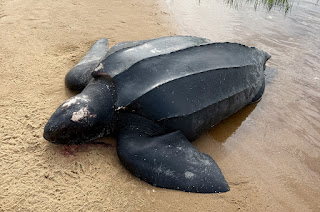The Gentle Giant of the Ocean
Exploring the World of the Leatherback Sea Turtle
When we think of sea turtles, we often imagine slow, graceful creatures gliding through the water with ancient wisdom in their eyes. Among these majestic animals, one stands out—not only because of its size but because of its uniqueness and mystery: the leatherback sea turtle (Dermochelys coriacea).
What Makes the Leatherback Special?
Unlike its hard-shelled cousins, the leatherback has a soft, leathery shell made of tough, rubbery skin stretched over a layer of oil-saturated connective tissue. This gives it a flexible, streamlined body that helps it dive to incredible depths and endure frigid ocean temperatures—far beyond what most reptiles can tolerate.
Here’s what makes the leatherback truly extraordinary:
Size: It’s the largest turtle in the world, growing up to 7 feet (2 meters) long and weighing over 2,000 pounds (900 kg).
Deep Divers: Leatherbacks can dive as deep as 4,000 feet (1,200 meters)—deeper than most whales!
Long-distance Travelers: These turtles undertake epic migrations across entire oceans, sometimes swimming over 10,000 miles a year in search of food.
Cold-Water Adaptation: Thanks to a unique ability called gigantothermy, they maintain a relatively stable body temperature, allowing them to forage in chilly waters from Canada to Norway.
A Jellyfish Diet
One of the leatherback’s most curious habits is its diet. Unlike other sea turtles that feed on seagrass or crustaceans, the leatherback has a soft spot for jellyfish. It uses its scissor-like jaws and backward-pointing spines in its throat to trap and swallow these gelatinous prey—sometimes eating hundreds a day.
This feeding habit plays a vital role in maintaining marine ecosystems. By controlling jellyfish populations, leatherbacks indirectly help fish populations thrive.
Life and Reproduction
Leatherbacks are mysterious and elusive. They spend most of their lives in the open ocean and only come ashore to nest. Females return to the same beaches where they were born, often after traveling thousands of miles, to lay eggs under the cover of night.
Each nest may contain around 80 to 100 eggs, but few hatchlings survive the gauntlet of predators and obstacles they face on their journey to the sea.
Endangered Giants
Despite their resilience, leatherbacks are critically endangered in many parts of the world. Their population has plummeted due to:
Plastic pollution: Mistaking floating plastic bags for jellyfish.
Fishing bycatch: Getting entangled in nets and lines.
Habitat loss: Coastal development disrupting nesting sites.
Climate change: Affecting both nesting success and ocean currents.
How You Can Help
You don’t have to live near an ocean to make a difference. Here are simple ways you can help leatherbacks:
Reduce plastic use: Say no to plastic bags, straws, and unnecessary packaging.
Support conservation groups: Donate or volunteer with organizations protecting sea turtles.
Be a responsible traveler: If visiting beaches where turtles nest, follow local guidelines.
Spread awareness: Share the leatherback’s story and encourage others to care.
Final Thoughts
The leatherback sea turtle is a living relic of the dinosaur age—a creature of strength, endurance, and beauty. Its epic migrations and ancient rhythms remind us of the deep interconnectedness of life in the oceans. If we act wisely and compassionately, we can ensure that this gentle giant continues to roam our seas for generations to come.

No comments:
Post a Comment